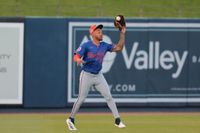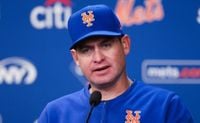The New York Mets entered Thursday with a solid record of 11 wins and 7 losses, positioning them atop the NL East. This promising start comes despite back-to-back defeats at the hands of the Minnesota Twins. Now, as they open a four-game series against the St. Louis Cardinals, the New York club aims to regain its momentum and return to winning form.
Injuries have been a recurring challenge for the Mets early this season, particularly affecting their pitching rotation. Nevertheless, the team has managed to post an impressive 2.38 ERA, the best in all of Major League Baseball. Unfortunately for the Queens-based franchise, the injured list continues to grow, with Thursday bringing particularly discouraging news that impacts the starting lineup.
During a game against the Athletics last Saturday, center fielder José Siri exited the field after striking his leg with a foul ball. On Thursday, the Mets confirmed that Siri had been diagnosed with a fractured left tibia and was placed on the 10-day injured list. This setback constitutes a major loss for the team’s outfield defense and speed on the bases.
The Mets announced roster moves in response to injury. “We’ve selected outfielder José Azócar to the Major League roster,” the team announced via its official X account. “Outfielder José Siri has been placed on the 10-Day IL with a left tibia fracture, and RHP Max Kranick has been recalled from Triple-A. We have optioned RHP Justin Hagenman to Triple-A following yesterday’s game.” These moves reflect the club’s immediate response to Siri’s absence, aiming to reinforce both the outfield and the bullpen.
Siri was one of the Mets’ offseason acquisitions, brought in to stabilize the center field position with his speed and elite defensive range, even though his career OPS+ of 87 remains below league average offensively. His absence now compels the team to determine who will assume the bulk of center field duties during his recovery.
José Azócar, the player promoted to take Siri’s spot on the roster, brings some experience to the position, having appeared in 63 MLB games as a center fielder over three seasons. Still, the drop-off in both range and speed presents a considerable challenge for the Mets, who will need to find internal solutions to stay competitive and preserve their lead in the NL East.
Meanwhile, the Mets are trying to bounce back from a tough loss to the Twins on Wednesday, April 16, 2025, where they fell 4-3 in a dramatic 10-inning showdown. The game marked the Major League debut of Justin Hagenman, a 28-year-old pitcher who had spent years in the Minors before finally getting his chance.
Before Hagenman took the Target Field mound, fewer than three dozen players drafted out of Penn State had appeared in a Major League game. Hagenman wasn’t a likely candidate to buck that trend, as a 23rd-round Draft pick of the Dodgers who spent years toiling in the Minors and who, after last season, joined a pile of more than 500 players to become Minor League free agents.
Yet there was Hagenman in the second inning Wednesday, making his Major League debut. “You just realize how bad you want it,” Hagenman said of his years spent in the Minors. With his parents, fiancée, brother, and others in attendance, most of them having traveled to Minnesota with little notice, Hagenman performed his job with aplomb, recording 10 outs, four via strikeout, with three hits and no walks.
As an emergency replacement for Griffin Canning, who was suffering from illness, Hagenman gave the Mets a chance to win. “He gave us what we asked him for,” manager Carlos Mendoza said. It was precisely the type of performance the Mets had signed Hagenman to provide.
After parts of six years in the Dodgers organization and two more with the Red Sox, Hagenman earned enough service time to reach Minor League free agency this offseason. He quickly became a target of several general managers, including Mets president of baseball operations David Stearns, who showed immediate interest and signed him to a split deal in November.
The Mets liked Hagenman’s repertoire, which included a cutter-sinker combination that made him effective against both right- and left-handed hitters, as well as a changeup and slider. While Hagenman’s velocity and spin rates may not have jumped off the page, Mets officials figured they could start him at Triple-A Syracuse and promote him when necessary.
“I don’t think there were a lot of adjustments that needed to be made,” Stearns said. “He just needed an opportunity.” When the chance finally came this week, Hagenman seized it. Initially, Mets officials told Hagenman to fly to Minneapolis just in case Canning’s illness lingered. So he and his fiancée hopped aboard a flight. While in transit, Hagenman received word that he would indeed be the bulk pitcher for the series finale against the Twins.
Whatever nerves Hagenman felt dissipated when he whiffed his first batter with a perfectly placed sinker. He wound up striking out three of the first four batters he faced, while the only run he allowed came home after he left the mound. “I think the first game is the hardest,” catcher Hayden Senger said. “But if you do it older, it’s kind of like, ‘All right. Here it is.’”
Senger would know. Earlier this season, he made his Major League debut at age 27, just one year younger than Hagenman. But unlike Senger, who’s now spent three weeks at the highest level, Hagenman is likely to return to the Minors on Thursday to make room for another reliever.
That’s the other thing Stearns liked about Hagenman’s dossier this offseason—his optionality, or the ability to shuttle him back and forth from the Minors without fear of losing him to another team. At this point, Canning has recovered enough from his illness to slot back into the rotation on Thursday, making the Mets’ rotation whole again.
As Hagenman himself put it, “You never know if this is a one-time opportunity.” Odds are that at some point, though, Hagenman will return. If and when he does, he’ll go into his next outing not just with the experience of a rookie who has been there, done that, but with that of a 28-year-old appreciative of the longer road that took him there. “Some guys, it might come quick,” Hagenman said. “Some guys, it takes some time. But it’s been everything you can hope for.”






